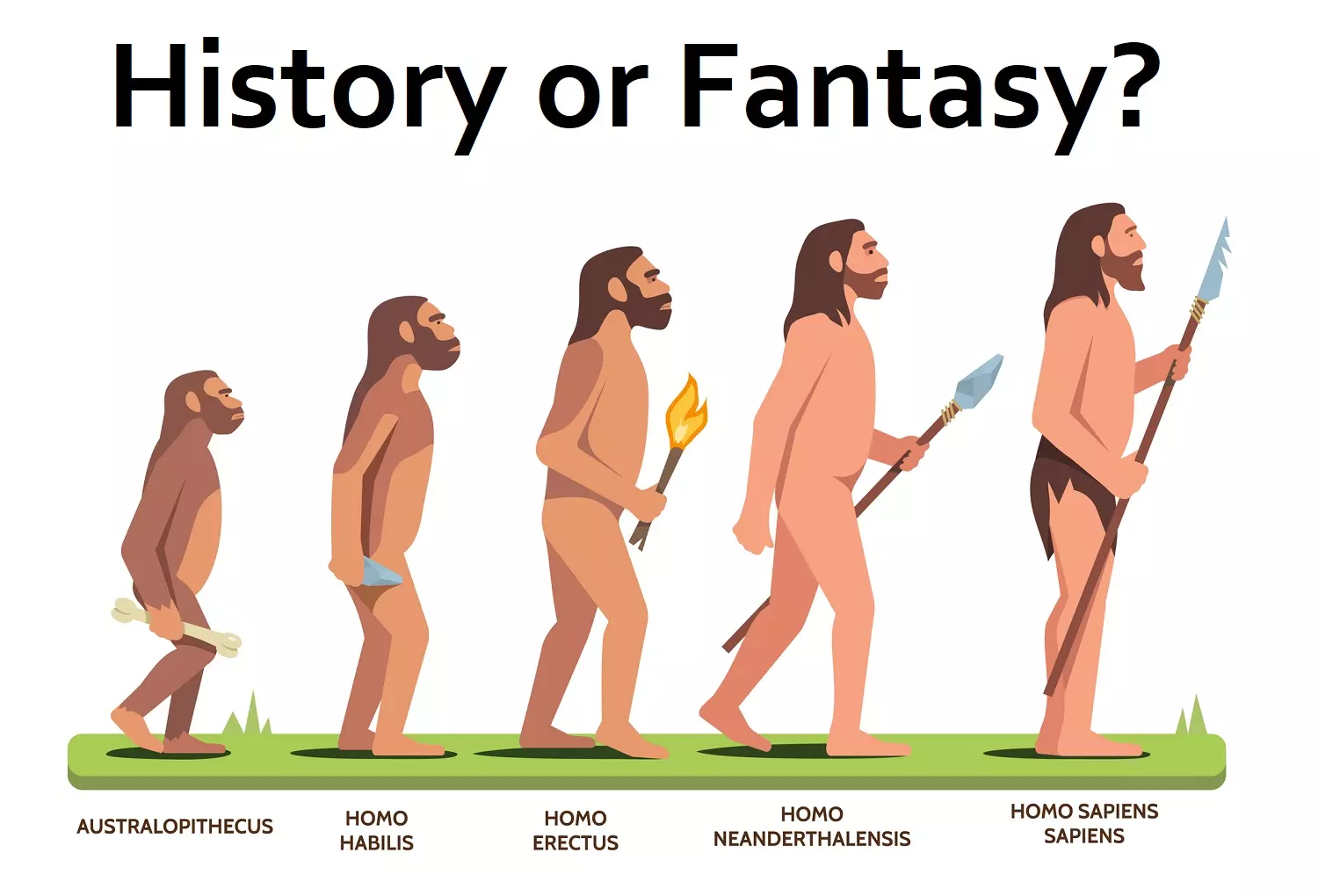[Originally published as part of the larger article on Jr. High Social Studies World History]
Homo habilis
…or “handy man” is often featured in sixth grade textbooks as some form of ape-to-human “transitional form.” Textbooks state confidently that he was our evolutionary ancestor who lived around 2.4 million years ago, and that scientists believe he was the missing link between australopithecines (apes) and Homo erectus (humans).
Are you ready for the rest of the story? In reality, Homo habilis is not just one fossil, it is a collection of fossils that have been the center of intense controversy and confusion. Here are some interesting facts about Homo habilis:
- In 1964, Louis Leaky, Phillip Tobias and John Napier announced in Nature the discovery of a new human ancestor: Homo habilis. The original fossils were said to be 1.8 million years old and consisted of scattered skull fragments, hand bones and foot bones from four juvenile specimens.
- According to Louis Leakey, the foot bones showed signs that Homo habilis may have been able to walk upright on two feet, and the hand bones indicated a high degree of manual dexterity. However, since these bones were not found next to the skull fragments, there was no concrete proof that they belonged to the same creature. Some scientists believed that the Homo habilis fossils were just a mixture of australopithecine (ape) and Homo erectus (human) fossils–not a new species.
- Some primitive stone tools were also found at the site. Originally scientists claimed these tools belonged to another supposed missing link known as Zinjanthropus (who incidentally, turned out to be just an ape). Now Louis Leakey claimed the tools were used by these new fossils. This was the reason for naming these fossils “Homo habilis” or handy man.
- In 1986, Tim White and Don Johanson discovered a partial adult skeleton. Since the fossil was discovered in Olduvai Gorge, it was designated “Olduvai Hominid 62” and was dated (by evolutionists) at 1.8 million years old. Because the skull and teeth were similar to the original Homo habilis fossils found in 1964, the new fossil was said to belong to the same species.
This presented three big problems for evolutionists!
- The body of Olduvai Hominid 62 was rather ape-like and smaller than the famous australopithecine fossil known as Lucy. Since Lucy was just slightly over three feet tall, and Homo erectus fossils grew to be about six feet, Olduvai Hominid 62 should have been somewhere in between them if Homo habilis was truly a missing link.
- Since the body of Olduvai Hominid 62 was ape-like, it seemed to support the belief that the original Homo habilis fossils found in 1964 were actually a mixture of australopithecine and human bones (most notably the hands and feet).
- If the fossilized hand and feet bones found in 1964 were actually human, then logically the tools found at that site were used by people living there.
Despite the bold statements made about Homo habilis in many school textbooks, paleoanthropologists are still trying to make sense out of this odd collection of fossils. Here is how evolutionist Richard Leakey described the problem:
Of the several dozen specimens that have been said at one time or another to belong to this species, at least half of them don’t. But there is no consensus as to which 50 percent should be excluded. No one anthropologist’s 50 percent is quite the same as another’s.”
So was Homo habilis really our ancestor? Not even evolutionists agree. Bernard Wood (George Washington University), regarded as being an expert on evolutionary trees (phylogenies) suggests that none of the Homo habilis fossils represent human ancestors:
“The diverse group of fossils from 1 million years or so ago, known as H. habilis, may be more properly recognized as australopithecines.”
Although evolutionists keep trying to convince us that humans evolved from ape-like creatures, interpretations of the fossil record have been filled with mistakes, fraud and fantasy. The truth is we were created by God on day six of creation week. Since the beginning, humans have always been humans and apes have always been apes.
Homo Erectus
The species name Homo erectus means “erect or upright man.” Evolutionists claim that various Homo erectus specimens fill up the gap between australopithecines (apes) and both Neanderthals and modern humans. Less than 300 fossils that have been labeled Homo erectus have been found—all of which have been labeled by creationists as either “fully ape” or “fully man.” One of the most famous specimens of this group has often been fabricated to support evolutionary theory.
So who/what are the Homo erectus fossils that have been found? A leading expert on human fossils, Marvin Lubenow, comments, “My own conclusion is that Homo erectus and Neandertal are actually the same: Homo erectus is the lower end, with regard to size, of a continuum that includes Homo erectus, early Homo sapiens, and Neandertal. The range of cranial capacities for fossil humans is in line with the range of cranial capacities for modern humans.”
Homo Sapien
Despite what public school textbooks say, creation science proves the point that Homo sapiens or Homo sapien sapiens, are all simply human!
Digging Deeper:
- Creation Ministries International Video: Artistic Ape Men Anecdotes, http://creation.com/
- Creation Ministries International Video: Ape Men, Missing Links and the Bible, http://creation.com/
- Bones of Contention, by Marvin L. Lubenow: http://store.icr.org/Bones-of-Contention/productinfo/BBOCO2/
Articles:
- http://creation.com/homo-erectus-to-modern-man-evolution-or-human-variability
- Fossil evidence for alleged apemen—Part 1: the genus Homo by Peter Line, Journal of Creation 19(1):22–32, April 2005.
- Homo erectus ‘to’ modern man: evolution or human variability? by A. W. (Bill) Mehlert, Journal of Creation 8(1):105–116, April 1994.
References
1. Bones of Contention, Marvin L Lubenow, (Michigan, Baker Books 1992, 2004): p 300
2. Richard Leakey and Roger Lewin, Origins Reconsidered, (New York: Doubleday 1992): p 112
3. Bernard Wood, “The age of australopithecines,” Nature 372, (3 November 1994): pp 31-32
4. Photo source: http://www.detectingdesign.com/earlyman.html
Digging Deeper:
- Creation Ministries International Video: Artistic Ape Men Anecdotes, http://creation.com/
- Creation Ministries International Video: Ape Men, Missing Links and the Bible, http://creation.com/
- Bones of Contention, by Marvin L. Lubenow: http://store.icr.org/Bones-of-Contention/productinfo/BBOCO2/
Articles:
- http://creation.com/fossil-evidence-for-alleged-apemenpart-1-the-genus-homo
- https://answersingenesis.org/creation-science/baraminology/homo-habilis-homo-rudolfensis-and-australopithecus-sediba/
- https://answersingenesis.org/creation-science/baraminology/homo-habilis-homo-rudolfensis-australopithecus-sediba-discussion/
- https://answersingenesis.org/human-evolution/ape-man/homo-erectus-to-modern-man-evolution-or-human-variability/
- http://www.icr.org/article/startling-discoveries-support-creation/
- https://answersingenesis.org/human-evolution/hominids/living-with-your-ancestors/







